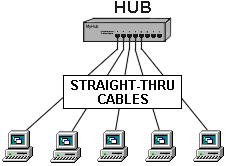What is the difference between an Ethernet hub and switch?
Although hubs and switches both glue the PCs in a network together, a switch is more expensive and a network built with switches is generally considered faster than one built with hubs. Why?
When a hub receives a packet (chunk) of data (a frame in Ethernet lingo) at one of its ports from a PC on the network, it transmits (repeats) the packet to all of its ports and, thus, to all of the other PCs on the network.
If two or more PCs on the network try to send packets at the same time a collision is said to occur. When that happens all of the PCs have to go though a routine to resolve the conflict.
The process is prescribed in the Ethernet Carrier Sense Multiple Access with Collision Detection (CSMA/CD) protocol. Each Ethernet Adapter has both a receiver and a transmitter. If the adapters didn’t have to listen with their receivers for collisions they would be able to send data at the same time they are receiving it (full duplex).
Because they have to operate at half duplex (data flows one way at a time) and a hub retransmits data from one PC to all of the PCs, the maximum bandwidth is 100 Mhz and that bandwidth is shared by all of the PC’s connected to the hub.
The result is when a person using a computer on a hub downloads a large file or group of files from another computer the network becomes congested. In a 10 Mhz 10Base-T network the affect is to slow the network to nearly a crawl. The affect on a small, 100 Mbps (million bits per second), 5-port network is not as significant.

Figure 1: Ethernet hub with 5 PC’s connected via Straight-thru Cable
Two computers can be connected directly together in an Ethernet with a crossover cable.
A crossover cable doesn’t have a collision problem. It hardwires the Ethernet transmitter on one computer to the receiver on the other. Most 100BASE-TX Ethernet Adapters can detect when listening for collisions is not required with a process known as auto-negotiation and will operate in a full duplex mode when it is permitted. The result is a crossover cable doesn’t have delays caused by collisions, data can be sent in both directions simultaneously, the maximum available bandwidth is 200 Mbps, 100 Mbps each way, and there are no other PC’s with which the bandwidth must be shared.
An Ethernet switch automatically divides the network into multiple segments, acts as a high-speed, selective bridge between the segments, and supports simultaneous connections of multiple pairs of computers which don’t compete with other pairs of computers for network bandwidth.
It accomplishes this by maintaining a table of each destination address and its port. When the switch receives a packet, it reads the destination address from the header information in the packet, establishes a temporary connection between the source and destination ports, sends the packet on its way, and then terminates the connection.

Figure 2: Crossover Cable Pinouts for 2 PC’s Network Interconnection
Picture a switch as making multiple temporary crossover cable connections between pairs of computers (the cables are actually straight-thru cables; the crossover function is done inside the switch).
High-speed electronics in the switch automatically connect the end of one cable (source port) from a sending computer to the end of another cable (destination port) going to the receiving computer on a per packet basis. Multiple connections like this can occur simultaneously.
It’s as simple as that. And like a crossover cable between two PCs, PC’s on an Ethernet switch do not share the transmission media, do not experience collisions or have to listen for them, can operate in a full-duplex mode, have bandwidth as high as 200 Mbps, 100 Mbps each way, and do not share this bandwidth with other PCs on the switch. In short, a switch is “more better.”
When Should I Use a Hub or Switch?
In a small network (less than 30 users), a hub (or collection of hubs) can easily cope with the network traffic generated and is the ideal piece of equipment to use for connecting the users.
When the network gets larger (about 50 users), you may need to use a switch to divide the groups of hubs, to cut down the amount of unnecessary traffic being generated.
If there is a hub or switch with Network Utilization LEDs, you can use the LEDs to view the amount of traffic on the network. If the traffic is constantly high, you may need to divide up the network using a switch.
Example of simple unmanaged switches can be found here: 8 port Fast Ethernet switch
Nowadays switches are getting more sophisticated and to extend a distance limitations for UTP copper cables (up to 100 m), fiber is extensively used and many switches will have fiber SFP ports, like this 8 port SFP slot switch.


